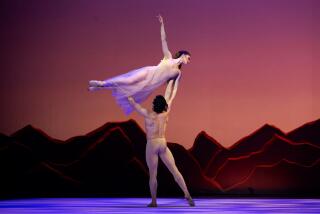Review: Mariinsky’s ‘Swan Lake’ sparkles (mostly)
“Swan Lake,” in the hands of the Mariinsky Ballet, is an experience of classicism that few can duplicate 117 years after the ballet’s premiere.
The St. Petersburg dancers and orchestra returned Tuesday with their three-hour-plus, Petipa-Ivanov classic to the Segerstrom Center for the Arts (continuing through Sunday). In rougher quarters, “Swan Lake” dives into war horse territory. To contemporary choreographers, such as Matthew Bourne and Mats Ek, its anachronistic story of love between a prince and an enchanted swan-woman has been fertile and successful ground for outrageous revisionism.
At the Mariinsky, however, the ballet’s soul is pure and worth preserving — although one can bemoan the cuts to the narrative mime and to the happy ending that revered dancer and choreographer Konstantin Sergeyev made in 1950. Even so, the Mariinsky “Swan Lake” is unique for its moody atmosphere and coherent style. Shunned qualities, such as delicacy, decorum and poetry, rise to the top, and virtuosity serves them, not the other way around.
This is the company’s seventh engagement at the Segerstrom Center since 1989, and with interim artistic director Yury Fateev at the helm, the company is at a crossroads. A new generation of soloists and young principals is moving into the spotlight, with some rough edges showing. Among these soloists is Oxana Skorik, a lithe and imaginative 23-year-old who was thrust into the opening night double role of swan queen Odette and her alter ego, Odile, when several more-senior ballerinas became pregnant and withdrew from the tour.
Skorik immediately announced her own interpretation. She has a naturally pliant torso, supple arms and exceptionally pointed feet, and she used her elegant carriage with fresh spirit. She danced with unmannered lyricism and illuminated Tchaikovsky’s score with ravishing, languid phrasing. She played the evil temptress Odile without jarring sauciness. She painted a rhythmic portrait through staccato gestures.
It’s clear why Skorik is being groomed for greater heights, but whether she has the strength and confidence to pull herself to the pinnacle is another matter. She drifted precipitously during the signature fouettée (whipped) turns and had to start again. Mistakes happen, but, as the British say, keep calm and carry on. Skorik, on the hand, was rattled and concluded the ballet in a bleaker humor.
FALL ARTS PREVIEW: Critic’s Picks
Her prince was the fresh-faced and boyish Vladimir Schklyarov, a more experienced principal with infectious charm. He shot skyward with grand jetés that just hung there and explosive beats, doling these out for maximum effect. For the first half, he was the melancholy Price with a black cloud dogging him. His astonishment at finding 32 perfectly synchronized swan-women affected us too. And stumbling upon Odette, his true love, became a believable miracle.
With that level of commitment, the two leads made a powerful and spontaneous connection. They were not perfectly matched physically, however, and a few partnering difficulties eventually cropped up. Not mortal blows, but breaks in the magic.
Magic, of course, is what these exquisitely streamlined men and women are selling. The ballet’s two white scenes were inspiring, with the corps de ballet of 32 gorgeously framing the lead couple in subtly shifting geometric patterns.
Konstantin Zverev brought a healthy dose of villainy, minus cartoonishness, to the sorcerer Rothbart. In the pas de trois, Maria Shirinkina and Alexey Popov pushed through their solos, occasionally distorting steps, while Nadezhda Batoeva sparkled effortlessly. Andrey Yakovlev as the tutor and Alexsey Nedviga as the jester both performed with light, gentle disposition.
The orchestra and conductor Mikhail Agrest were similarly successful at shaping beautiful musical phrasing. Violin soloist Lyudmila Chaikovskaya’s lovely tone matched Skorik’s delicate ache up at the high notes. Another rare artistic pairing.
MORE:
CRITIC’S PICKS: Fall Arts Preview
TIMELINE: John Cage’s Los Angeles
More to Read
The biggest entertainment stories
Get our big stories about Hollywood, film, television, music, arts, culture and more right in your inbox as soon as they publish.
You may occasionally receive promotional content from the Los Angeles Times.










